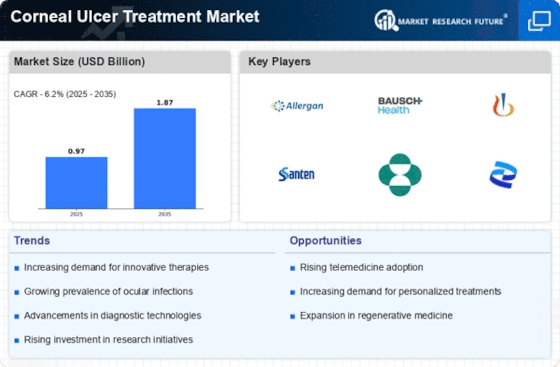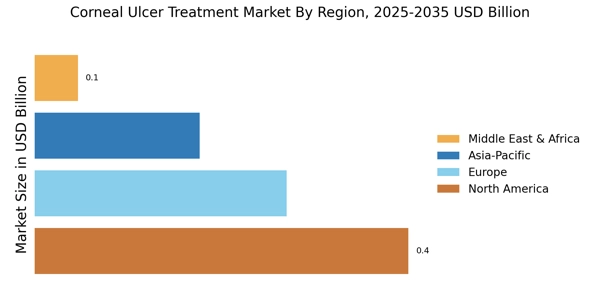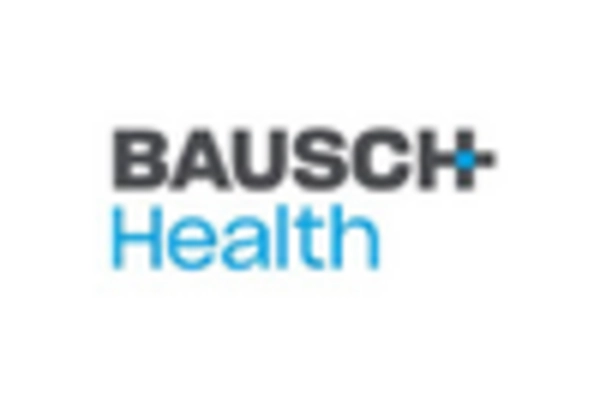Rising Awareness of Eye Health
There is a notable increase in public awareness regarding eye health, which serves as a significant driver for the Corneal Ulcer Treatment Market. Educational campaigns and initiatives by health organizations are emphasizing the importance of regular eye examinations and prompt treatment of eye conditions. This heightened awareness is leading to earlier detection of corneal ulcers, which is crucial for effective treatment. Moreover, the proliferation of information through digital platforms has empowered patients to seek timely medical advice. As individuals become more informed about the risks associated with untreated corneal ulcers, the demand for effective treatment options is likely to rise, thereby benefiting the Corneal Ulcer Treatment Market.
Emergence of Novel Therapeutics
The emergence of novel therapeutics is reshaping the landscape of the Corneal Ulcer Treatment Market. Recent advancements in pharmacology have led to the development of targeted therapies that address the underlying causes of corneal ulcers, rather than merely alleviating symptoms. These innovative treatments, including gene therapy and regenerative medicine approaches, hold the potential to revolutionize patient outcomes. As clinical trials demonstrate the efficacy of these new therapies, healthcare providers are expected to adopt them into standard treatment protocols. This shift not only enhances the treatment landscape but also drives competition within the Corneal Ulcer Treatment Market, encouraging further research and development.
Increasing Healthcare Expenditure
The escalation of healthcare expenditure across various regions is a crucial driver for the Corneal Ulcer Treatment Market. Governments and private sectors are investing more in healthcare infrastructure, which includes eye care services. This trend is particularly evident in developing nations, where improved access to healthcare facilities is leading to higher diagnosis rates of corneal ulcers. According to recent data, healthcare spending is projected to grow at a compound annual growth rate of over 5% in the coming years. This increase in funding allows for better training of healthcare professionals and the procurement of advanced treatment modalities, thereby enhancing the overall efficacy of the Corneal Ulcer Treatment Market.
Advancements in Medical Technology
Technological innovations in the field of ophthalmology are significantly influencing the Corneal Ulcer Treatment Market. The introduction of advanced diagnostic tools, such as optical coherence tomography and corneal topography, enhances the accuracy of corneal ulcer diagnosis. Furthermore, the development of novel therapeutic agents, including antimicrobial and anti-inflammatory medications, has improved treatment outcomes. The market is witnessing a shift towards minimally invasive surgical techniques, which not only reduce recovery times but also enhance patient satisfaction. As these technologies become more accessible, healthcare providers are likely to adopt them, thereby expanding the Corneal Ulcer Treatment Market. The integration of telemedicine also offers new avenues for patient management, particularly in remote areas.
Growing Incidence of Eye Disorders
The rising prevalence of eye disorders, particularly corneal ulcers, is a pivotal driver for the Corneal Ulcer Treatment Market. Factors such as increasing exposure to environmental pollutants, prolonged use of contact lenses, and a surge in eye injuries contribute to this trend. According to recent estimates, the incidence of corneal ulcers has been reported to affect millions worldwide, with a notable increase in cases among individuals aged 50 and above. This demographic shift, coupled with a growing awareness of eye health, propels the demand for effective treatment options. As healthcare systems prioritize eye care, investments in research and development for innovative therapies are likely to rise, further stimulating the Corneal Ulcer Treatment Market.


















Leave a Comment